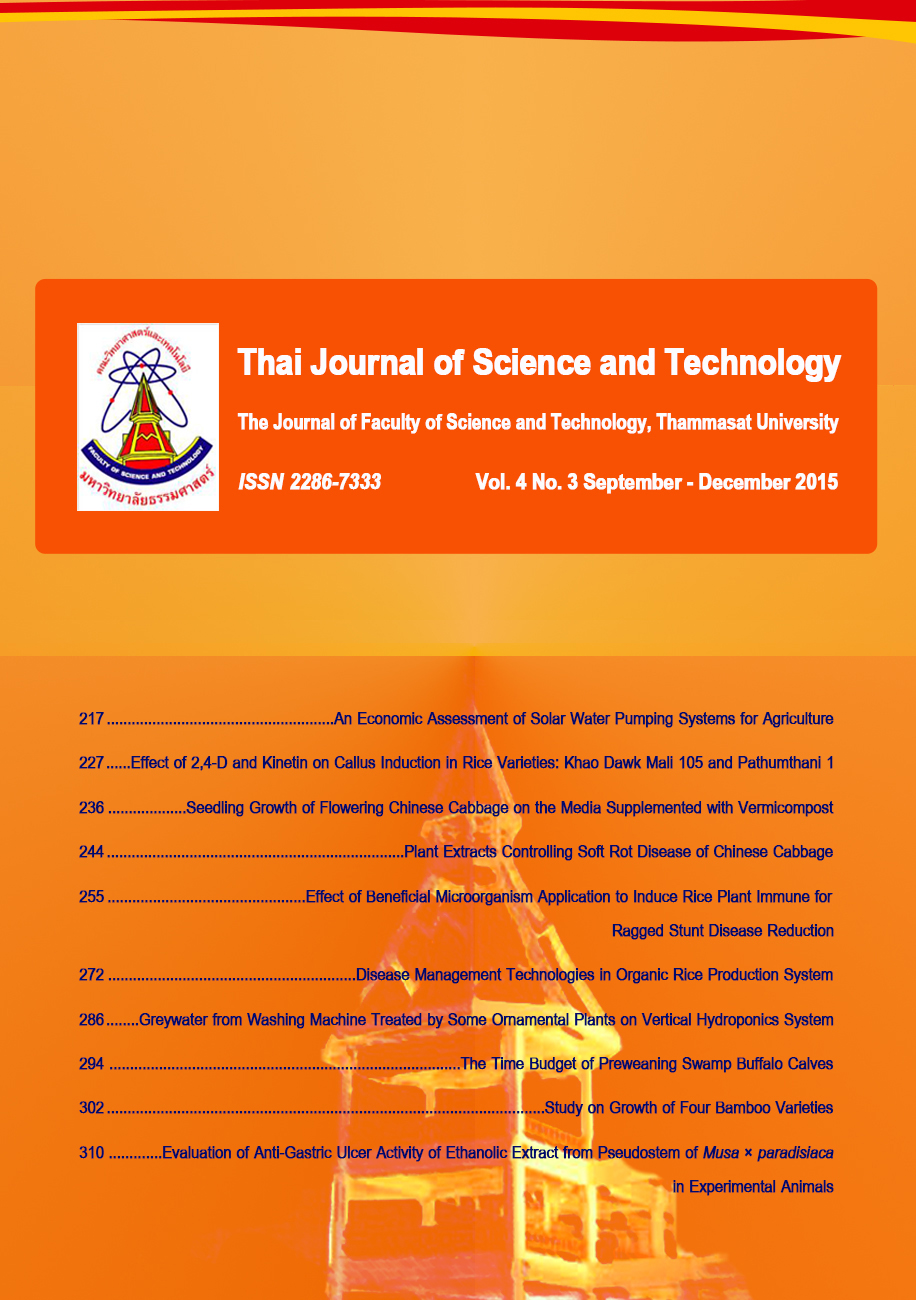สารสกัดหยาบพืชควบคุมโรคเน่าเละของผักกาดขาวปลี
Main Article Content
บทคัดย่อ
บทคัดย่อ
การศึกษาครั้งนี้ได้ทดสอบประสิทธิภาพของสารสกัดพืช 5 ชนิด ได้แก่ ใบฝรั่ง ใบพลู เปลือกทับทิม รากหญ้าคา และหัวแก่นตะวัน ในการยับยั้งการเจริญของ Erwinia carotovora subsp. carotovora สาเหตุโรคเน่าเละของผักกาดขาวปลี ทั้งในสภาพห้องปฏิบัติการและเรือนปลูกพืชทดลอง การสกัดหยาบพืชทั้ง 5 ชนิด โดยใช้สารตัวทำละลายเอทานอล 95 % เอทิลอะซิเตท เฮกเซน และน้ำ กรองและระเหยแห้งภายใต้สภาพสูญญากาศ ผลการวิจัยพบว่าสารสกัดหยาบใบพลูในเอทานอล 95 % และในเอทิลอะซิเตทมีประสิทธิภาพในการยับยั้งเชื้อสาเหตุโรคเน่าเละได้ดีที่สุด โดยแสดงบริเวณยับยั้ง 27 และ 26 มิลลิเมตร ตามลำดับ (p=0.05) ยิ่งไปกว่านั้นยังพบว่าเอทานอล 95 % เอทิลอะซิเตท และน้ำแสดงความสามารถในการสกัดสารสำคัญจากพืชได้แตกต่างกัน โดยสารสกัดหยาบใบพลูที่สกัดด้วยเอทานอล 95 % แสดงแถบของสารออกฤทธิ์ที่สำคัญ 2 แถบ ที่มีค่า Rf = 0.37 และ 0.70 เมื่อตรวจสอบด้วยวิธี thin-layer chromatography ขณะที่เอทิลอะซิเตทแสดงแถบของสารออกฤทธิ์ที่สำคัญจากใบพลู 4 แถบ ที่ Rf = 0.37, 0.44, 0.59 และ 0.70 ส่วนน้ำแสดงแถบของสารออกฤทธิ์ที่สำคัญจากใบพลู 1 แถบ ที่ Rf = 0.37 จากการตรวจสอบด้วยวิธีเดียวกัน ความเข้มข้นที่เหมาะสมของสารสกัดหยาบใบพลูที่สกัดด้วยเอทานอล 95 % และเอทิลอะซิเตทในการยับยั้ง E. carotovora subsp. carotovora ได้แก่ 7.5 และ 10 % ตามลำดับ นอกจากนี้การใช้สารสกัดหยาบใบพลูในเอทิลอะซิเตท 10 % ทุก 7 วัน จำนวน 5 ครั้ง หรือทุก 14 วัน จำนวน 3 ครั้ง (เมื่อ 0, 7, 14, 21 และ 28 วัน หรือ 0, 14 และ 28 วันหลังปลูกเชื้อในดิน) มีประสิทธิภาพในการควบคุม E. carotovora subsp. carotovora สูงที่สุด (p=0.05) แสดงให้เห็นว่าสารสกัดหยาบใบพลูในเอทิลอะซิเตทมีประสิทธิภาพสูงในการควบคุมเชื้อสาเหตุโรคเน่าเละ ซึ่งอาจนำไปสู่การค้นหาสารออกฤทธิ์ที่สำคัญต่าง ๆ จากพืชดังกล่าว การศึกษาวิจัยนี้จึงสนับสนุนการใช้ภูมิปัญญาท้องถิ่นในการใช้ประโยชน์จากพืชท้องถิ่นในการลดหรือทดแทนการใช้สารเคมีทางการเกษตรในโปรแกรมการจัดการโรคพืชอย่างยั่งยืน
คำสำคัญ : การควบคุมโรคพืชโดยชีววิธี; ลดการใช้สารเคมี; เกษตรยั่งยืน; เกษตรอินทรีย์
Abstract
In this study, the efficacy of 5 plant extracts from guava leaf, betel leaf, pomegranate peel, blady grass root, and sunchoke tuber were tested on the growth inhibition of Erwinia carotovora subsp. carotovora, the causal agent of soft rot disease of Chinese cabbage under laboratory and greenhouse conditions. The plant crude extracts were prepared by using 95 % ethanol, ethyl acetate, hexane, and water and filtrated and evaporated under vacuum. The 95 % ethanol and ethyl acetate individual extract of betel leaf could inhibit the growth of soft rot pathogen by showing 27 and 26 mm. clear zone respectively (p=0.05). Moreover, we found that 95 % ethanol, ethyl acetate, and water showed different capacity extraction. The 95 % ethanol betel leaf extract showed 2 different bands of the important active ingredient at Rf = 0.37 and 0.70, detected by thin-layer chromatography whereas ethyl acetate; and water extracts showed 4; and 1 important active ingredient bands at Rf = 0.37, 0.44, 0.59, and 0.70; and 0.37, respectively. The suitable concentration of 95 % ethanol and ethyl acetate betel leaf extract against E. carotovora subsp. carotovora were 7.5 and 10 %, respectively. Furthermore, the application of 10 % of ethyl acetate betel leaf extract every 7 days 5 times or 14 days 3 times (at 0, 7, 14, 21 and 28 or at 0, 14 or 28 days after E. carotovora subsp. carotovora inoculated in the soil), were the most effective against E. carotovora subsp. carotovora (p=0.05). It was concluded that extract of betel leaf showed the most effectiveness on growth inhibition of soft rot pathogen which may be due to their active ingredients. The results support the local wisdom in using local plants to reduce or replace the agrochemical in sustainable plant disease management program.
Keywords: biological control; reduced agrochemical; sustainable agriculture; organic farming
Article Details
บทความที่ได้รับการตีพิมพ์เป็นลิขสิทธิ์ของคณะวิทยาศาสตร์และเทคโนโลยี มหาวิทยาลัยธรรมศาสตร์ ข้อความที่ปรากฏในแต่ละเรื่องของวารสารเล่มนี้เป็นเพียงความเห็นส่วนตัวของผู้เขียน ไม่มีความเกี่ยวข้องกับคณะวิทยาศาสตร์และเทคโนโลยี หรือคณาจารย์ท่านอื่นในมหาวิทยาลัยธรรมศาสตร์ ผู้เขียนต้องยืนยันว่าความรับผิดชอบต่อทุกข้อความที่นำเสนอไว้ในบทความของตน หากมีข้อผิดพลาดหรือความไม่ถูกต้องใด ๆ


